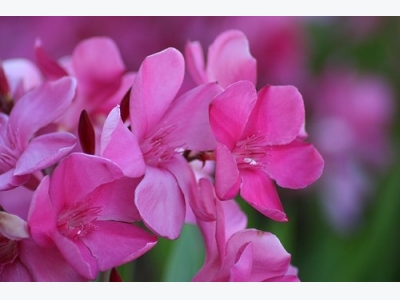How to Grow Oleander

Photo found on Flickr, courtesy of Swami Stream.
Oleander is a shrub or small tree that blooms in summer with large, striking flowers in shades of red, white, light yellow, and pink. Because of its dense branching and rapid growth rate it is a popular hedge. Planting an oleander hedge is an excellent way to hide utilities, chain link fences, and other eyesores in the landscape. It also makes an attractive specimen plant if planted singly or in a garden border.
While it can reach twenty feet, oleander takes well to pruning and is typically kept at six to ten feet. Tolerant of dry soils and hot sun, oleander is an excellent plant for the desert, but can thrive in warm, humid climates as well.
Growing Requirements for Oleander
For the best flowering, plant oleanders in full sun, but in very hot climates they bloom more reliably in light shade. Oleanders tolerate a range of soil conditions, from dry sandy soils to moist clay soils. They grow best where the weather stays above freezing, although they can tolerate short periods of below-freezing temperatures.
Depending on how the plants are to be used and the size of the cultivar, the ideal planting distance ranges from five to ten feet. In the right climate oleander is easy to grow and requires no special care beyond annual pruning and feeding.
Pruning Oleander
Prune after flowering to stimulate new branches, control size and shape, avoid leggy growth, and encourage next year’s flower buds. Remove suckers, which can interfere with flowering, and dead branches.
Oleander Propagation
Propagate oleanders by taking cuttings of healthy, young stems in summer and rooting them in a mix of sand and peat.
Oleander Pests and Diseases
Oleanders generally have no serious insect or disease problems. In humid climates aphids and scale insects may be a problem. Caterpillars can strip oleander leaves in just a few days.
Oleander Toxicity
All parts of oleander are poisonous. They contain a toxic chemical that can cause illness, skin irritation, or even death if eaten in enough quantity. Fortunately the plant has an acrid taste that causes a gagging reaction in most people that causes them to throw up. Burning oleander also causes toxicity, so it should never be put in a burn pile, nor should it be used as a stake for roasting food over a fire.
Wearing gloves while working with oleander may prevent allergic skin reactions. Because of its toxicity, oleander is not recommended for playgrounds or other places children play.
Related news
 Growing Roses from Collected Seeds
Growing Roses from Collected Seeds Roses are probably the most popular flower grown by organic gardeners, given their beauty, scent, and hardiness.
 Zucchini Squash Diseases: Common Diseases Of Zucchini Plants
Zucchini Squash Diseases: Common Diseases Of Zucchini Plants Zucchini plants are one of the easiest vegetables to grow. Provided with full sun, well-drained soil with plenty of organic matter worked into it and water
 Rose Bush Seeds – How To Grow Roses From Seeds
Rose Bush Seeds – How To Grow Roses From Seeds Propagating roses from seed take a little time, but is easy to do. Let’s take a look at what it takes to start growing roses from seed.